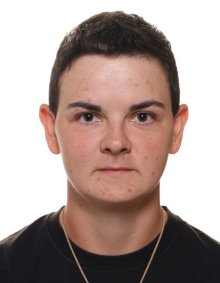| Citace |
Artificial selection and its impact on genome in wolfdogs (Canis familiaris) - , 2024 |
NERADILOVÁ, S. – **SCHAUER, A. – **HAYWARD, J. – **BRUNNER, M. – **BOHUTÍNSKÁ, M. – **JAGANNATHAN, V. – **CONNELL, L. – **BOYKO, A. – **WELLE, M. – ČERNÁ BOLFÍKOVÁ, B. Genomic and Transcriptomic Characterization of Atypical Recurrent Flank Alopecia in the Cesky Fousek. Genes, 2022, roč. 13, č. 4, s. 1-25. ISSN: 2073-4425. |
MUSA, A. – NEEDHAM, T. – KOTRBA, R. – NERADILOVÁ, S. – **GANSWINDT, A. – CEACERO HERRADOR, F. Habituation of common eland (Taurotragus oryx) to intensive routine handling, and the effect of immunocastration thereon. Applied Animal Behaviour Science, 2021, roč. 237, č. 105294, s. 1-7. ISSN: 0168-1591. |
MUSA, A. – NEEDHAM, T. – KOTRBA, R. – NERADILOVÁ, S. – **GANSWINDT, A. – CEACERO HERRADOR, F.Habituation of common eland (Taurotragus oryx) to intensive routine handling, and the effect of immunocastration thereon. 2021, This is a Poster presentation given at the 29th Animal Science Days conference, at the Hungarian University of Agricultural and Life Sciences Kaposvár Campus (MATE-KC), Gödöllő, Hungary from September 15 to 17, 2021.
Abstract:
Common eland (Taurotragus oryx) are considered as undomesticated, and maintain their natural prey instincts, making it necessary to habituate them to routine handling. Within this study, data was collected to determine the influence of routine handling and immunocastration on the temperament of common eland. Twenty-nine common eland were divided into two groups: sub-adults (n=15; ca. 2 years old) and juveniles, and were routinely handled every two weeks, over a four-month period. Within each age group, females, males, and immunocastrated males were present. Immunocastration treatment was administered during the second and fourth handling events (2mL Improvac®/ animal). During handling, animals were individually driven through the raceway and finally restrained in a squeeze chute, where routine biological samples and measurements were collected. Faecal androgen metabolite (fAM) concentrations were measured for each event, for males only. Each animal was focally sampled for specific behaviours during the handling. A temperament score was obtained by observing the general state of the animal from the point of entering the raceway, until its exit from the squeeze chute. Generalized linear mixed models tested the influence of immunocastration, week, group, fAM concentration, and body weight on the temperament score. Immunocastration did not affect the temperament score, the general state in the squeeze chute, the order of entering the handling system, and the chute exit. However, the temperament score and the state in the squeeze chute improved overtime (less nervous). Moreover, animals with low temperament scores (calm animals) entered the system earlier and exited the system calmly over the repeated handling period. The results show that routine handling through a raceway and squeeze chute system leads to habituation and improves the ease of handling in common eland. However, immunocastration did not affects the temperament of the male common eland during handling.
Authors:
Abubakar S. Musa1*, Tersia Needham1, Radim Kotrba1,2, Silvie Neradilova1, Andre Ganswindt3, Francisco Ceacero1
1 Department of Animal Science and Food Processing, Faculty of Tropical AgriSciences, Czech University of Life Sciences Prague, 165 00 Prague, Czech Republic
2 Department of Ethology, Institute of Animal Science, Přátelství 815, Prague 10- Uhříněves, 104 00, Czech Republic
3 Mammal Research Institute, Department of Zoology and Entomology, Faculty of Natural and Agricultural Sciences, University of Pretoria, South Africa. |
NERADILOVÁ, S. – **HAYWARD, J. – CEACERO HERRADOR, F. – **CONNELL, L. – **BOYKO, A. – ČERNÁ BOLFÍKOVÁ, B.Geny či prostředí: Které faktory zodpovídají za projevy ztráty psí srsti?. 2020, . |
NERADILOVÁ, S. – **CONNELL, L. – **HULVA, P. – ČERNÁ BOLFÍKOVÁ, B. Tracing genetic resurrection of pointing dog breeds: Cesky Fousek as both survivor and rescuer. PLoS One, 2019, roč. 14, č. 8, s. 1-12. ISSN: 1932-6203. |
JINDŘICHOVÁ, M. – NERADILOVÁ, S. – **HULVA, P. – ČERNÝ, J. – BERNÁTHOVÁ, I. – **MATĚJŮ, P. – ČERNÁ BOLFÍKOVÁ, B.Ovčácká plemena psů a jejich genetická rozmanitost. 2019, Licenční smlouva TAČR gama
Konference Zoologické dny 2019, 7. - 8. 2. 2019, Brno. |
NERADILOVÁ, S. – **BOYKO, A. – **HAYWARD, J. – **CONNELL, L. – **WELLE, M. – **LEEB, T. – ČERNÁ BOLFÍKOVÁ, B.Osvětlí genom českého fouska záhadu ztráty srsti?. 2019, Konference Zoologické dny 2019, Brno. |
JINDŘICHOVÁ, M. – NERADILOVÁ, S. – **HULVA, P. – **CAMATA, A. – ČERNÁ BOLFÍKOVÁ, B.Czechoslovakian wolfdogs – do they differ across Europe?. 2018, Zoologické dny 2018, Praha. |
ČERNÁ BOLFÍKOVÁ, B. – SMETANOVÁ, M. – NERADILOVÁ, S. – **HULVA, P.Genetic diversity of Czech local breeds regarding their complicated history. 2017, 12th International Mammalogical Congress
Perth, Western Australia, 9 – 14 July 2017. |
NERADILOVÁ, S. – SMETANOVÁ, M. – HULVA, P. – ČERNÁ BOLFÍKOVÁ, B.Genový tok v rámci plemene český fousek. 2016, . |
NERADILOVÁ, S. – ČERNÁ BOLFÍKOVÁ, B. – SMETANOVÁ, M. – CHURAVÁ, M. – HULVA, P. Podtyp: Příspěvek ve sborníku (mimo kategorie RIV); Genový tok v rámci plemene český fousek. 2015, Zoologické dny v Brně 2015. |
NERADILOVÁ, S. – ČERNÁ BOLFÍKOVÁ, B. – SMETANOVÁ, M. – CHURAVÁ, M. – HULVA, P. Podtyp: Příspěvek ve sborníku (mimo kategorie RIV); Genový tok v rámci plemene český fousek. 2015, Studentská konference MASTER 2015. |
 |
FAPPZ
PEF
TF
FŽP
FLD
FTZ
IVP
|
Statky
Lesy
Vinařství
|
KTV
OIKT
SIC
KAM
|
@
|
|
FAPPZ
PEF
TF
FŽP
FLD
FTZ
IVP
|
Statky
Lesy
Vinařství
|
KTV
OIKT
SIC
KAM
|
@
|

